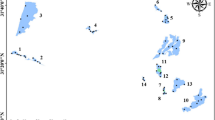Abstract
Estimation of abundance or biomass of benthic invertebrates requires considerable effort to process samples. Consequently, it has been suggested to process only organisms retained by a relatively coarse meshed sieve and apply size-specific correction factors based on the probability that a sieve retains individual organisms. Benthic samples were collected from 10 sites in 2 regions and processed to validate an existing empirical model predicting sieve retention probabilities, to test whether periphyton biomass affects probability of retention, and to determine the optimal strategy that minimizes both cost and variability of estimates. The existing model predicting sieve retention probabilities corrected for organisms lost through sieves and mostly corrected for underestimation of biomass, but this model lead to overestimates of the frequency of the smallest organisms. Inclusion of algal biomass improved slightly the proportion of correct predictions (whether an organism is retained or not by a sieve) by 0.6% relative to the existing model (from 90.8% to 91.4%), and removed the bias. Density and biomass estimates obtained by only processing organisms retained by 1- or 2-mm sieves and applying correction factors derived from the predicted retention probabilities were accurate and only marginally less precise than estimates obtained by processing all organisms. The reduced precision of estimates from subsets of organisms could be compensated by increasing sample size and still lead to a reduction of 40–60% of the number of organisms processed. Even though the use of subsets introduces additional analytical variability, this variability is relatively small compared to the natural spatial variability among replicates.




Similar content being viewed by others
References
Bachelet, G., 1990. The choice of a sieving mesh size in the quantitative assessment of marine macrobenthos: a necessary compromise between aims and constraints. Marine Environmental Research 30: 21–35.
Benke, A. C., A. D. Huryn, L. A. Smock & J. B. Wallace, 1999. Length–mass relationships for freshwater macroinvertebrates in North America with particular reference to the southeastern United States. Journal of the North American Benthological Society 18: 308–343.
Hosmer, D. W. & S. Lemeshow, 2000. Applied Logistic Regression, 2nd edn. Wiley, New York.
Hudson, P. L. & J. V. Adams, 1998. Sieve efficiency in benthic sampling as related to chironomid head capsule width. Journal of the Kansas Entomological Society 71: 456–468.
Logan, B. E., 1993. Theoretical analysis of size distributions determined by screen and filters. Limnology and Oceanography 38: 372–381.
Morin, A., 1985. Variability of density estimates and the optimization of sampling programs for stream benthos. Canadian Journal of Fisheries and Aquatic Sciences 42: 1530–1534.
Morin, A., J. Stephenson, J. Strike & A. G. Solimini, 2004. Sieve retention probabilities of stream benthic invertebrates. Journal of the North American Benthological Society 23: 383–391.
Ostrofsky, M. & F. H. Rigler, 1987. Chlorophyll–phosphorus relationships for subarctic lakes in western Canada. Canadian Journal of Fisheries and Aquatic Sciences 44: 775–781.
Schlacher, T. A. & T. H. Wooldridge, 1996a. How accurately can retention of benthic macrofauna by a particular mesh size be predicted from body size of organisms? Hydrobiologia 323: 149–154.
Schlacher, T. A. & T. H. Wooldridge, 1996b. How sieve mesh size affects sample estimates of estuarine benthic macrofauna. Journal of Experimental Marine Biology and Ecology 201: 159–171.
Southwood, T. R. E., 1966. Ecological Methods. John Wiley & Sons, New York, NY: 391.
Acknowledgements
This study was supported by a NSERC Grant (RGPIN-42799-2001) to AM. We thank Dr. Jan Benda and Jaynie Stephenson for stimulating discussions, and Yuan Yao for her help with sample processing and data entry.
Author information
Authors and Affiliations
Corresponding author
Additional information
Handling editor: K. Martens
Rights and permissions
About this article
Cite this article
Gruenert, U., Carr, G. & Morin, A. Reducing the cost of benthic sample processing by using sieve retention probability models. Hydrobiologia 589, 79–90 (2007). https://doi.org/10.1007/s10750-007-0722-6
Received:
Revised:
Accepted:
Published:
Issue Date:
DOI: https://doi.org/10.1007/s10750-007-0722-6




